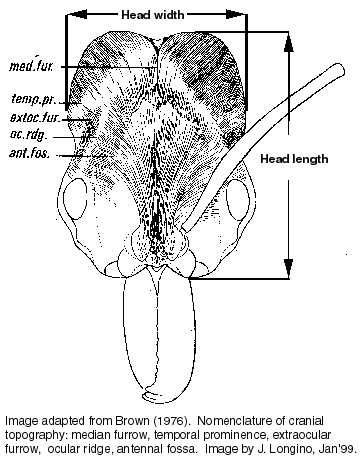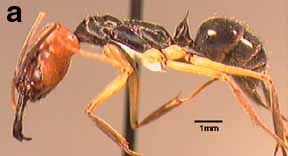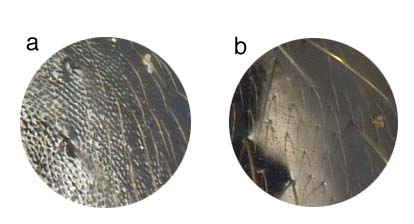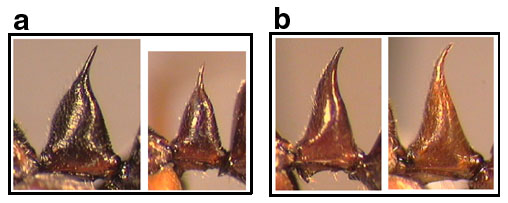
| Genus List | Species List |
This key is based partially on Brown (1976) and Deyrup et al. (1985).
Measurements (from Brown 1976):
Head length (HL): in full-face view, distance from the posteriormost margin of head capsule to anteriormost limit of rounded anterior swellings of the mandibular condyles.
Head width (HW): greatest width across the temporal prominences (note: this is not the greatest width across the head, which is across the eyes and ocular prominences).
Mandible length (ML): measured in the same plane as HL, from the anteriormost limit of rounded anterior swellings of the mandibular condyles to the tip of the closed mandibles. Thus HL and ML do not overlap, but are contiguous. Also, since the mandibles may be tilted ventrad, ML is not necessarily the maximum length of the mandibles.
Scape length (SL): maximum measurable length of the scape or chord of the scape, omitting the radicle or basal condylar neck, but including all of the main shaft of the scape and its inner basal acute angle.
Cephalic index (CI): (HW*100)/HL.
Mandibular index (ML): (ML*100)/HL.
Scape index (SI): (SL*100)/HW.

10a. Dorsal surface of head distinctly striate to or nearly to the posterior margin: 100
10b. Posterior third to half of dorsal surface of head smooth and shining or nearly so: 800

100a. Top of first gastral segment predominantly smooth, punctulate, alutaceous, or reticulate; striation absent, or if present, mixed with other sculpture and distinct only on the posterior half: 200
100b. Top of first gastral segment distinctly and evenly striate over its entire surface, at least as seen from dorsal view: 700

200a. Head more or less bright red (frontal area often infuscate), contrasting with blackish-brown body and yellow legs: erythrocephalus
200b. Color combination otherwise; if head is distinctly red, then trunk is red also, or legs are dark: 250

250a. Top of first gastral segment as seen from above densely punctulate; opaque or nearly so: 300
250b. Top of first gastral segment otherwise sculptured; shining or surface sometimes alutaceous, shagreened, or even with traces of striation in the posterior portion: 400

300a. Large black or dark brown species (head length, not including mandibles, greater than or equal to 3mm); top of first gastral segment densely and regularly punctulate throughout; longest hairs of gastral dorsum 0.6mm or more in length: opaciventris
300b. Small light or dark brown species (head length less than 2.5mm); top of first gastral segment very densely punctulate, opaque, longitudinally striate over a posterior portion of variable extent; longest hairs of gastral dorsum less than 0.6mm long: meinerti

400a. Head, trunk and petiole nearly or quite concolorous light red or dull yellow; legs yellowish, gaster light brown to blackish; posterior face of petiole convex in both directions; compound eye distinctly longer than maximum width of mandible (without teeth) (EL 0.50, cf. Brown 1976); sides of head, especially the part posterior to extraocular furrow, finely, densely and distinctly reticulate-punctulate and dull (known only from the types from "embouchure du Jesus Maria, cote pacifique de Costa Rica, dans du bois pourri"): biolleyi
400b. Not fitting the above description: 420
420a. Petiolar node with posterior face convex to base of well differentiated dorsal spine: 500
420b. Petiolar node with posterior face flat; in lateral view node tapered to apex, without differentiated dorsal spine: 600

500a. Head length often above 2.5mm; color always dark brown to black; petiolar node with relatively more convex anterior face; (common species in canopy and in open and/or dry habitats; less common in wet forest understory; more often encountered on Pacific slope): bauri
500b. Head length 2.2-2.4mm (n=4); color variable, often in a gradient from legs to head to mesosoma to gaster, with legs light red orange, and gaster dark brown; petiolar node as seen from the side with anterior face relatively less convex than bauri (occurs in beach edge habitats, open disturbed areas, less common in mature wet forest areas): ruginodis

600a. Head length often above 2.8mm; pubescence on first gastral tergum suberect and relatively uniform, not wooley (common ground forager on both slopes; wet and dry habitats): laticeps (part)
600b. Head length 2.5mm (n=1); pubescence on first gastral tergum dense, short, fine, giving gaster a wooley appearance (one specimen known from open pasture at rainforest edge, Braulio Carrillo National Park, 500m elevation): brunneus

700a. Striation of gastral dorsum curved-transverse; large, slender species: chelifer
700b. Striation of gastral dorsum longitudinal; grades into form with smooth gastral dorsum: laticeps (part)

800a. Large species (head length greater than 2.8mm); scapes at least slightly longer than head; vertex narrow (HW/HL less than 0.55): hastatus
800b. Smaller species (head length less than 2.4mm); scapes shorter than head; vertex wider (HW/HL greater than 0.55): panamensis

Literature Cited
Brown, W. L., Jr. 1976. Contributions toward a reclassification of the Formicidae. Part VI. Ponerinae, tribe Ponerini, subtribe Odontomachiti. Section A. Introduction, subtribal characters. Genus Odontomachus. Studia Entomol. 19:67-171.
Deyrup, M., J. Trager, N. Carlin 1985. The genus Odontomachus in the southeastern United States (Hymenoptera: Formicidae). Entomological News 96:188-195.
Page author:
John T. Longino, The Evergreen State College, Olympia WA 98505 USA.longinoj@evergreen.edu